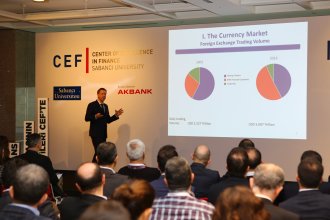CEF, hosted Columbia Business School international finance and foreign currency markets expert Prof. Geert Bekaert as part of a seminar series.
Sabancı University Center of Excellence in Finance (CEF) established with the founding sponsorship of Akbank held another seminar as part of its series with leading international academics. International Finance Expert and Columbia Business School Finance Professor Geert Bekaert visited Turkey for a lecture on "Currency Rate Factors”.
Columbia Business School Finance Professor Geert Bekaert's lecture at the Sabancı Center on Friday, April 20 was titled "Currency Rate Factors” and was attended by participants from bank treasuries, financial intermediaries, import/export divisions of manufacturing companies, and trading desks.
Sabancı University Finance Chair and CEF Founding Chairperson Professor Özgür Demirtaş expressed their pleasure to host a global academic like Prof. Geert Bekaert. Demirtaş continued, "CEF is continuing to organize certificate programs and series of seminars on finance in its second year. CEF has already become a leader in finance education in Turkey", and emphasized the importance of having a person as important as Geert Bekaert for the lecture.
Professor Bekaert summarized recent research on currency rate factors
An expert on the efficiency of foreign currency markets, macro economics, global market integration, and international stock markets, Prof. Bekaert discussed recent research on "currency rate factors" that may prove beneficial for the management of foreign currency portfolios or all other international portfolios susceptible to currency rate fluctuations.
Prof. Bekaert first focused on the ability of existing and new factor models to explain the correlation between the currency rate changes in G10 countries, and discussed the use of a "currency basket", a novel concept that represents the overall movement of a particular currency.
A dual-bloc structure to joint movements in currency rates
Professor Bekaert summarized carry, volatility, value and momentum factors among the types of extant currency rate factors, and said that a clustering analysis reveals a dual-bloc structure in currency rate comovements, with the first bloc being primarily composed of the US dollar, and the second bloc of European currencies.
According to Professor Bekaert, "Regardless of the currency rate perspective, a new parsimonious factor model that includes this 'clustering' factor fits all bilateral exchange rates well. The model also sheds light on a significant portion of fluctuations in currency rates in developing countries.”
Professor Bekaert discussed factors on currency rates in developing markets
Professor Bekaert took a closer look at the carry factor and focused on the distinction between "good" and "bad" carry trades constructed from G10 currencies.
Professor Bekaert stated, "Good strategies exhibit higher Sharpe ratios and sometimes positive revenue skewness, while bad strategies come with substantially lower Sharpe ratios and higly negative skewness. Interestingly enough, good carry trades do not involve the most typical carry currencies like the Australian dollar or Japanese yen.”
Prof. Bekaert finally discussed the factors existing in developing market currency rates.



6698 sayılı Kişisel Verilerin Korunması Kanunu (“Kanun”) uyarınca, kişisel verileriniz; veri sorumlusu olarak Sabancı Üniversitesi (“Üniversite”) tarafından aşağıda açıklanan kapsamda işlenebilecektir.
Sabancı Üniversitesi’nin, bilimde, teknolojide ve toplum üzerinde dönüştürücü etkileri olan yenilikçi araştırma ve eğitim faaliyetlerindeki öncü konumu çerçevesinde Sabancı Üniversitesi Finans Mükemmeliyet Merkezi’nin düzenlediği programların (“Program”) bitiminde tarafınıza sunulmak üzere tercihinize bağlı olarak katılım sertifikanızın NFT (non-fungible token) şeklinde hazırlanması arzu edilmektedir. Hızlı gelişen günümüz dünyasında oldukça popüler olan NFT’ler tümüyle dijital nitelikli varlıklar olup, dijital bir varlığın sahipliğini kanıtlayabilen ve bu varlığın benzersiz olduğunu onaylayan, blok zinciri (blockchain) adı verilen dijital defterde depolanan veri birimleridir. Program bitiminde tarafınıza tercihinize bağlı olarak katılım sertifikanızın NFT olarak sunulması amacıyla işlenebilecek kişisel verileriniz ile ilgili olarak sizleri bilgilendirmek isteriz. Bu çerçevede;
Kişisel Verilerin Hangi Amaçlarla İşleneceği ve Hukuki Sebebi
Toplanan kişisel verileriniz, aşağıda yer alan amaçlar (“Amaçlar”) ve hukuki sebepler ile Kanun’un 5. maddesinde belirtilen kişisel veri işleme şartları ve amaçları dahilinde işlenebilecektir.
Bir sözleşmenin kurulması veya ifasıyla doğrudan doğruya ilgili olması kaydıyla, sözleşmenin taraflarına ait kişisel verilerin işlenmesinin gerekli olması hukuki sebebine dayalı olarak;
İlgili kişinin temel hak ve özgürlüklerine zarar vermemek kaydıyla, veri sorumlusunun meşru menfaatleri için veri işlenmesinin zorunlu olması hukuki sebebine dayalı olarak;
Bir hakkın tesisi, kullanılması veya korunması için veri işlemenin zorunlu olması hukuki sebebine dayalı olarak;
Kanunlarca açıkça öngörülmesi ve veri sorumlusunun hukuki yükümlülüğünü yerine getirebilmesi için zorunlu olması hukuki sebebine dayalı olarak;
Açık rızanızın varlığı halinde;
İşlenen Kişisel Verilerin Kimlere ve Hangi Amaçla Aktarılabileceği
Toplanan kişisel verileriniz; yukarıda yer alan Amaçlar’ın gerçekleştirilmesi doğrultusunda kanunlarda açıkça öngörülmesi ve hukuki yükümlülüklerimizin yerine getirilmesi kapsamında kanunen yetkili kamu kurumları ve kanunen yetkili özel kişilere, açık rızanızın varlığı halinde, açık rızanıza dayalı olarak Program kapsamında tarafınıza katılım sertifikanızın NFT şeklinde sunulması amacıyla kullanılan OpenSea NFT platformunun sağlayıcısı sunucuları yurt dışında bulunan Ozone Networks, Inc.’e ve diğer Program katılımcılarına Kanun’un 5. maddesinde düzenlenen kişisel veri işleme şartları çerçevesinde Kanun’un 8. ve 9. maddelerinde belirtilen kişisel verilerin aktarılmasına ilişkin kurallara uygun olarak aktarılabilecektir.
Kişisel Veri Toplamanın Yöntemi
Kişisel verileriniz, Üniversitemiz tarafından yukarıda belirtilen Amaçlar doğrultusunda elektronik ortamda e-posta, çevrim içi formlar, internet sitemiz, tarafınızla gerçekleştirdiğimiz telefon görüşmeleri ve fiziki ortamda katılım formları üzerinden toplanmaktır.
İlgili Kişinin Kanun’un 11. Maddesinde Sayılan Hakları
Kişisel verilerinize yönelik Kanun’un 11. maddesi uyarınca aşağıdaki haklara sahip olduğunuzu bildiririz:
Yukarıda yer alan haklarınıza ilişkin taleplerinizi sizi tanımamıza ve iletişime geçebilmemize yardımcı olabilecek şekilde kimlik (ad-soyad, T.C. kimlik numarası), telefon, e-posta, adres bilgilerinizi de ekleyerek yazılı ve imzalı olarak Sabancı Üniversitesi Orta Mahalle Üniversite Caddesi No:27 Tuzla İstanbul adresine posta ile taahhütlü gönderebilir, şahsen başvurunuzu teslim edebilir veya ilgili başvurunuzu sabanciuniversitesi@hs03.kep.tr adresine güvenli elektronik imzalı olarak iletebilirsiniz. Üniversitemiz talebin niteliğine göre talebi en kısa sürede ve en geç otuz gün içinde ücretsiz olarak sonuçlandıracaktır. Ancak, işlemin ayrıca bir maliyeti gerektirmesi hâlinde, Üniversitemiz tarafından Kişisel Verileri Koruma Kurulunca belirlenen tarifedeki ücret alınabilecektir.